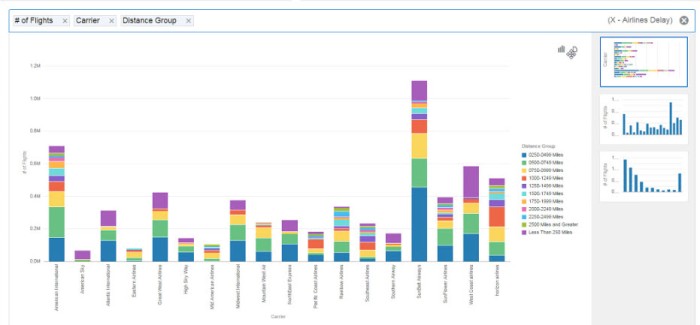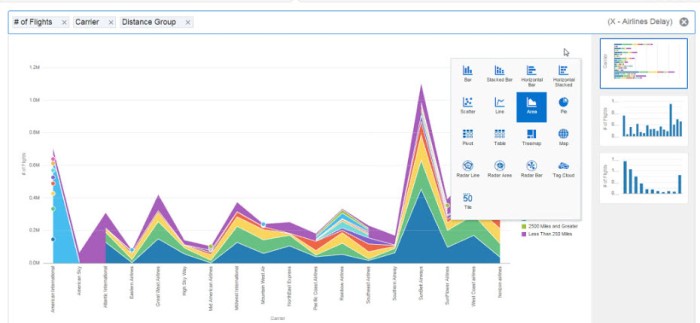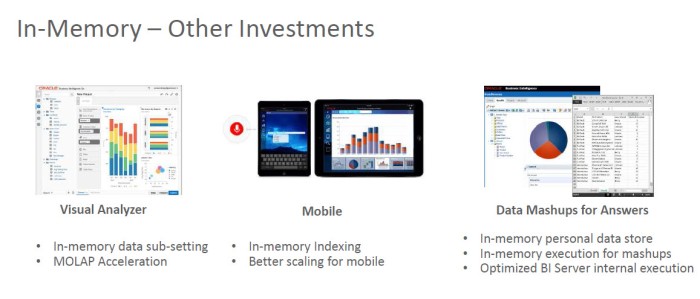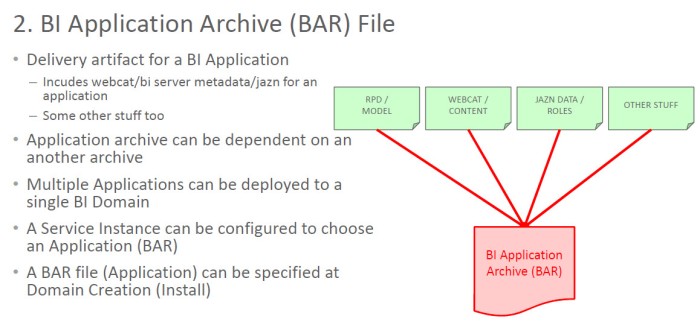OBIEE 12c has been launched with couple of Brand new exciting features and with couple of major enhancements from its predecessor. The enhancement has been made in Visualizations, Platform Architecture, Installation and Configuration, Migration and deployment. Also major enhancement made on the directory structures and no more complicated lengthy path of Weblogic directories and its more clean and pristine.
Lets isolate each areas and see what are the major enhancements:
- Installation And Configurations
- Multi-tenancy (MSI) and Pluggable BI
- BI Application Archive(BAR)
- OBIEE Server level enhancements – In-memory analytics and Advanced analytics
- Data Mashups for Answers
- Visual Analyzer
- Better Mobile Analytics
I am going to touch the UI enhancement first on Visual Analyzer (as I know this is going to be very attractive features and major highlight of this release).
A) VISUAL ANALYZER
- VA is a very strong web based tool has new generation Answers capability for self-service analysis.
- VA is quick data exploration and data discovery tool which can build rich dashboards on-the-fly in very quick turnaround time. Rich analysis possible with drag and drop configuration
- It has very easy and swift transitioning palette and quick slice and dice features.
- Very simple user friendly input which can create very rich graphics with different options of exploring the data, discovering the patterns and seeing trends.
- Provide highly interactive experience with intuitive filtering and cross visualization brushing and highlighting
- Visual Analyzer is not intended to be a standalone reporting tool. Visual Analyzer makes use of the existing Oracle BI EE
repository, which means that all your Oracle BI EE 11g data sources can be leveraged to allow users to explore existing data warehouse content. - Visual Analyzer uses Presentation Services data models as a content source, relies on the catalog to store content, uses the search infrastructure to find content and relies on a common security model for managing roles and permissions.
- VA use rich modern java-script library and rendered through HTML5
- Using VA you can create advanced graph, blend of color , size , shape , palette using various co-ordinate systems
You can modify and manipulate data model on-the-fly

 VA Integrates any kind of data source, it is powerful tool to load and model data. You can smartly blend the personal and external data.
VA Integrates any kind of data source, it is powerful tool to load and model data. You can smartly blend the personal and external data.
It has a nice global searching capabilities on any measure/object name like Qlikview.
B) DATA MASHUP
You can upload your own datafile like xls data , match with existing OBIEE model and generate on the fly customized reporting. Internally its logical SQL extension to directly call external data. Just in time modelling with measures and attributes, mashup across enterprise and user defined data.
Data mashup also include OBIEE embedded data store for user uploaded files.
A simple MASHUP Architecture like below :
C) Advanced Analytics Capability
Predictive analysis is more tightly integrated, enabling customers to more easily forecast future conditions based on existing data points, group elements that are statistically similar, and expose outliers. BI 12c includes the ability to run the free Oracle R distribution on BI Server, and extend existing analytics with custom R scripts, which can point to any engine (R, Oracle Database, Spark, etc.) without needing to change the BI RPD to deliver results.
D) In-Memory Analysis
E) 11g to 12c UPGRADE – Pluggable Model and BAR/BVL
Oracle BI Baseline Validation Tool – Complete New Capability
• A tool that enables the creation of a baseline set of data that is then able to be compared with data from another (or the same) system that may be the result of an upgrade, patch or migration, or any change
• A way to perform regression testing on any two compatible Oracle BIEE environments
–Works within and across 11g and 12c versions
• A way to instill confidence when performing an upgrade, migration or significant change to an existing environment
• A tool that enables the creation of a baseline set of data that is then able to be compared with data from another (or the same) system that may be the result of an upgrade, patch or migration, or any change
• A way to perform regression testing on any two compatible Oracle BIEE environments
–Works within and across 11g and 12c versions
• A way to instill confidence when performing an upgrade, migration or significant change to an existing environment
 The baseline validation tool interfacing both 11g(Pre-Upgrade) and 12c (Post-Upgrade) which will give the capability of easy testing plus validating data set, Logical query pre and post upgrade. It is going to a a very essential feature and reduce lot of testing time and effort for sure. Oracle called this as Pluggable model.
The baseline validation tool interfacing both 11g(Pre-Upgrade) and 12c (Post-Upgrade) which will give the capability of easy testing plus validating data set, Logical query pre and post upgrade. It is going to a a very essential feature and reduce lot of testing time and effort for sure. Oracle called this as Pluggable model.
The following modules will be available here:
– Data verification
• Compare result output (i.e. actual numbers or text) from different versions
– Visual verification
• Capture screenshots of reports to check they are visually the same
– BI catalog verification
• Capture object and metadata and compare with the target system
– Logical query verification
• Capture logical query definitions and compare with the target system
– Performance verification
• Capture performance profile to check there’s not degradation
– Data verification
• Compare result output (i.e. actual numbers or text) from different versions
– Visual verification
• Capture screenshots of reports to check they are visually the same
– BI catalog verification
• Capture object and metadata and compare with the target system
– Logical query verification
• Capture logical query definitions and compare with the target system
– Performance verification
• Capture performance profile to check there’s not degradation
F) Multi-Tenancy Model / Multi-Service Instance (MSI) enabled
Multitenancy refers to a principle in software architecture where a single installation of the software runs on one server or clustered servers, serving multiple client organizations.With a multitenant architecture, each client organization operates
independently of other organizations that share the same infrastructure. Multitenancy offers the ability to host multiple companies (even competitors) in one deployment without them knowing of each other.
independently of other organizations that share the same infrastructure. Multitenancy offers the ability to host multiple companies (even competitors) in one deployment without them knowing of each other.
G) System Administration and Configuration
- Single Source for BIPLATFORM schemas. No Information on DB and topology info stored in Database
- Full offline configuration speed up domain creation
- Separate OBIEE Installation and Config (it was just reverse than 11g when RCU creation was first step)
- Chef Capability allow most of the config parameters to be edited
- One place to edit environment and/or configuration so no more duplication in config files
- BI 12c will use CAM (not OPMN) to manage system components.All CAM-related configuration is also stored in DOMAIN_HOME.
- Singleton Data Directory (SDD)– Simple conversion to HA scale-out
- Zero downtime: All system and application operations should be supported on-line. No requirement for downtime of end-user functionality
- Support offline configuration: All system and application configuration operations should be off-line. No requirement for run-time mid-tier processes to be started.
- No more Middleware Home and all under one Oracle_Home.
- No more OPMN . Everything managed inside weblogic
- Migration process has been simplified in great extent using BAR files and easy validation tool pre and post migration
- The Oracle BI Server supports the Fast Application Notification (FAN) event and Fast Connection Failover (FCF) Oracle Database configuration. It is excllent feature to add offline failover of the database connections. Fast Connection Failover enables quick failover when the data source’s Oracle database is not available. According to the documentation, This functionality will run in the background. When an Oracle Business Intelligence query initiated by an analysis user fails due to the Oracle database being unavailable, the query will fail quickly and the user can then retry the query rather than waiting for the database request to time out.
- Invoke of the WLST from a single location
H) Mobile Analytics
- Sharp Mobile UI interfacing with rich colors
- Mobile Indexing data
- Fast Mobile data query
- Keyword search (“BI Ask”) empowers users to literally talk to their data, asking questions and having visualizations automatically created as responses, opening up an easy entry point for authoring. Additionally, the interface for iOS has been completely redesigned; and Mobile BI for Android offers sharing and following for nearby devices, as well as the ability to project any dashboard or story to GoogleCast-enabled devices.























No comments:
Post a Comment